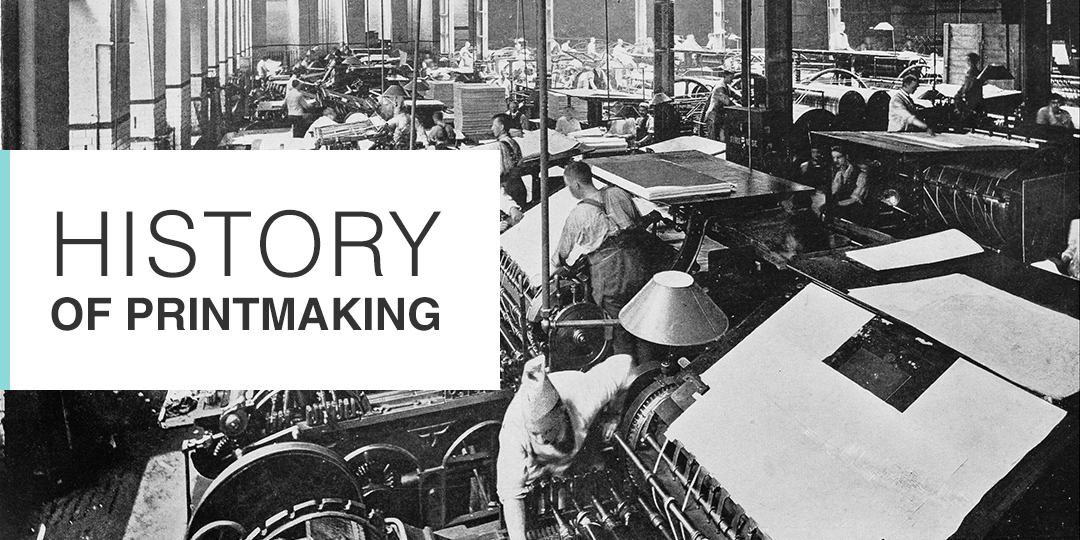What Is Printmaking?
Printmaking entails applying ink to one surface and printing that ink onto another surface. The printmaking process includes several types and techniques. To ensure a successful print, it’s essential to have the appropriate pressure and quality equipment.
Types of Printmaking
Printmaking can be divided into four main types. All four methods involve adding an inked impression onto a surface and transferring that ink onto another. What differs is how the ink is transmitted. The types of printmaking include:
- Relief
- Intaglio
- Planographic
- Stencil
Printmaking Techniques
An artist can use several techniques to print their designs, and these methods can fall under any of the four main types of printmaking. Engraving, lithography, woodcut and etching are some of the more traditional art print techniques.
Modern techniques, such as screenprinting and digital printing, have become the norm. However, some artists and art enthusiasts still prefer the enchanting results of traditional methods.
Relief Techniques
Relief printmaking is one of the more basic types and requires a raised inked surface. By removing areas from a material that you don’t want to be inked and inking only raised areas, you can easily transfer the image onto a surface. Relief techniques include:
- Linocut
- Woodcut
Intaglio Techniques
Intaglio is relief printmaking in reverse. Lines and designs are cut into a metal surface like zink or copper before pushing the ink inside these lines. A tool like a burin or sometimes an acid substance, such as with etching, indents the matrix. Once the matrix is wiped clean, it’s placed on a wet piece of paper, where the ink designs are transferred. Some intaglio techniques are:
- Spit-bite aquatint
- Mezzotint
- Etching
- Engraving
- Drypoint
- Photogravure
- Aquatint
Stencil Techniques
With stencil printmaking, artists make an outline of their design. They place the stencil over a sheet of silk and use a sponge to ink the silk surface, resulting in a printed image. Recently, synthetic nylon has been more widely used than silk, but the primary concepts remain the same. Stencil techniques include:
- Screenprinting
- Pochoir
Planographic and Other Techniques
Planography works on the principle that water and oil don’t mix. A greasy substance, usually tusche, is used to draw a design on a flat surface. Once you add water and ink, only the surface area with oil will absorb the ink, printing the design.
Leveraging various planographic techniques and materials results in unique images:
- Digital printing
- Foil imaging
- Collagraph
- Handmade paper
- Lithography
- Monotype printmaking
- Monoprinting
History of Printmaking
Printmaking is a unique art form that blends creativity and technical skill. Through the centuries, printmaking has required incredible handiwork and the ingenuity to create visually interesting and evocative artwork. Soon after the art form was invented, the importance of printmaking became realized. It offered immense value to society as an art form that allowed images and text to be reproduced. Prints could be distributed to everyday people who couldn’t necessarily afford one-of-a-kind oil paintings. Printmaking allowed societies to disseminate information through mass-produced books, religious illustrations and maps.
As printmaking has served many practical purposes through its storied past, it is highly valued as an art form. Today, an original print from a talented artist is a thing of beauty and holds much value to art collectors and enthusiasts.
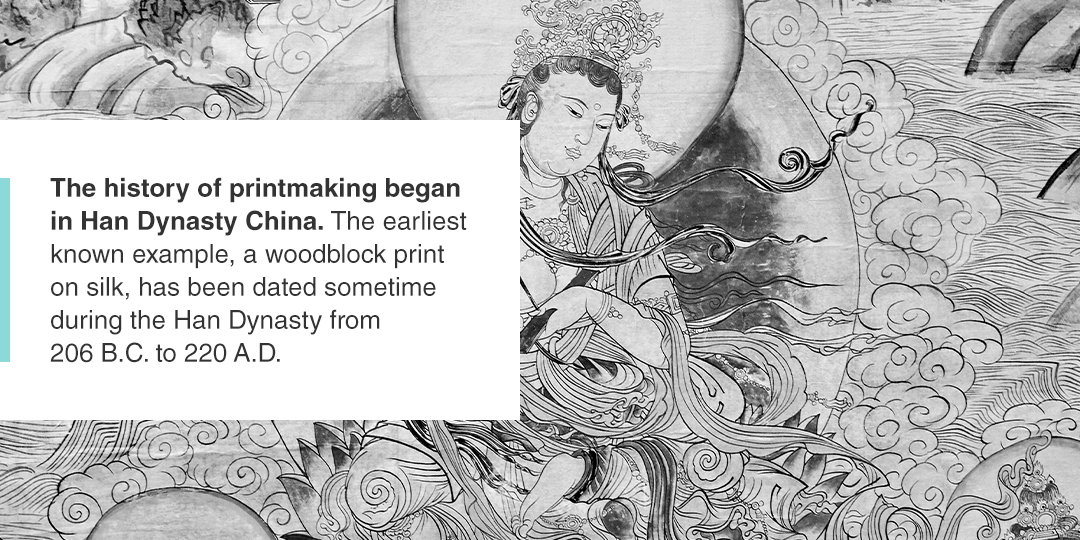
About Printmaking Through the Ages
Printmaking is an art form that involves transferring images from a matrix, or template, onto another surface, usually paper or fabric. A printmaker creates the matrix out of wood, metal, glass or other material, using tools or chemicals to work the surface into an image. The artist then inks the template and transfers it onto another surface.
Traditional printmaking methods, including woodcut, etching, engraving and lithography, require a printing press to provide even pressure. The printmaking process lets artists create many iterations of the same image. Throughout history, it’s served as an affordable way to communicate and share art.
The history of printmaking began in Han Dynasty China. The earliest known example, a woodblock print on silk, has been dated sometime during the Han Dynasty from 206 B.C. to 220 A.D. The first print on paper was made during the seventh century.
The original form of printmaking used a small wooden board as the matrix. Carving away from the wood would create negative space on the print after the ink was transferred onto fabric or paper. When the Chinese introduced movable type sometime between 1041 and 1048 and improved on the design over the coming centuries, bookmaking became much more possible and versatile. Since then, printmaking has spread throughout the world, serving many purposes and artists over the centuries.
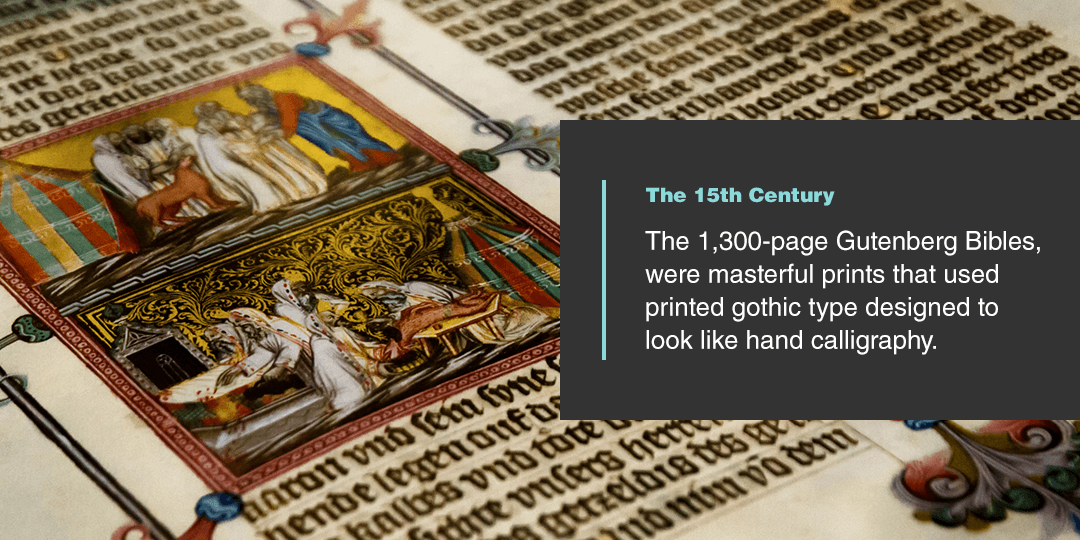
The 15th Century
The earliest European prints date back to the beginning of the 15th century when woodcut prints were used to make paper playing cards in Germany. The technique soon passed down to artists, who used it to render bold figures against blank backgrounds. As the practice evolved, artists began creating more complicated designs, with architecture and landscapes in the background and elaborate borders.
Metal engraving, the first intaglio printing form, arrived a few decades later and soon became the most popular printmaking technique for its refined results. The images combined tiny dots and short cuts punched into the surface. Unlike woodcuts, the metal matrix’s sunken areas held the ink, which was transferred onto paper. The earliest known intaglio print is the 1446 German print, “The Flagellation.” The technique soon traveled to Italy and throughout Europe.
Perhaps the most significant contribution to printmaking from the 15th century, Johannes Gutenberg’s printing press revolutionized the art form and the culture. While not the original inventor, Gutenberg perfected the movable type printing press around 1450 and popularized it in Europe. His most famous works, the 1,300-page Gutenberg Bibles, were masterful prints that used printed gothic type designed to look like hand calligraphy.
The 16th Century
In the early 16th century, printmaking masters emerged. The most notable was Albrecht Dürer, a German artist whose travels in Italy let him influence the printmaking world across Europe. His work brought great detail to his subject matter, including religion, history, folklore, mythology, and portraiture. He worked in woodcuts, etchings, drypoints, and metal engravings.
Another notable master from the era, Albrecht Altdorfer, was the first to print landscapes as subjects rather than as backgrounds. The Flemish engraver, Hendrik Goltzius, used his cuts to imitate different surfaces and textures. In Italy, Marcantonio Raimondi’s rise marked a turning point in the printmaking art form. A technical master rivaling Dürer, he became the engraver to Raphael. He printed reproductions of the famous painter’s work and was influential in reducing printmaking from an original art form to the craft of reproducing famous works.
During the later half of the 16th century, publishing houses and skilled artisans took over the printing world. Printed maps became increasingly popular as people began traveling more frequently. Publishers would also buy plates from their original artists and print them in massive quantities, sometimes ruining the original plates in the process.
The 17th Century
As engraving became increasingly commercialized and reproductive, artists in the 17th century turned to etching. Acid etching was seen as more creative, flexible and honorable. As Italy became a center for the technique, printmaker Guido Reni developed the distinctive Italian style of delicate lines and dots.
Italy-based French artist Jacques Callot gained the most acclaim as the first printmaker to use repeated acid bitings to create tonal variations. He also used his own custom-made etching needle to recreate the swelling and tapering lines characteristic of engraving.
In the Netherlands, etching saw another creative explosion. Hercules Seghers, a true experimenter, created many unorthodox prints, such as printing on colored canvases or placing white lines on dark backgrounds. He developed a unique style dominated by rocky landscapes. While many artists in Holland created masterful etchings, the famous Rembrandt has stood the test of time. Through his roughly 300 plates, he rendered everything from religious and historical subjects to the most mundane activities. He explored every possibility of the etched line and later experimented by combining etching and drypoint.
During this century, the Japanese art form ukiyo-e emerged, marking a break from the culture’s heavily Chinese-influenced works. These refined and highly stylized woodcuts depicted everyday life. The first master of the form was Hishikawa Moronobu, who used street scenes, peddlers and crowds as subject matter.
The 18th Century
Italy remained the center for European printmaking throughout the 18th century. One of the century’s first masters, Giovanni Battista Tiepolo, was famous for his delicate, rhythmic patterns. Canaletto’s inventive use of lines and textures mimicked color and light through his printed graphics. As a master architectural printmaker, Giovanni Battista Piranesi was prolific, with 3,000 large etchings to his name.
Satirist William Hogarth ushered printmaking into England with his national school. His influence quickly sparked works from fellow caricaturist Thomas Rowlandson. The poet William Blake took printmaking into new experimental forms in his book illustrations. Meanwhile, Spain’s first great printmaker, Francisco de Goya, used satire to comment on human folly, war and religious persecution.
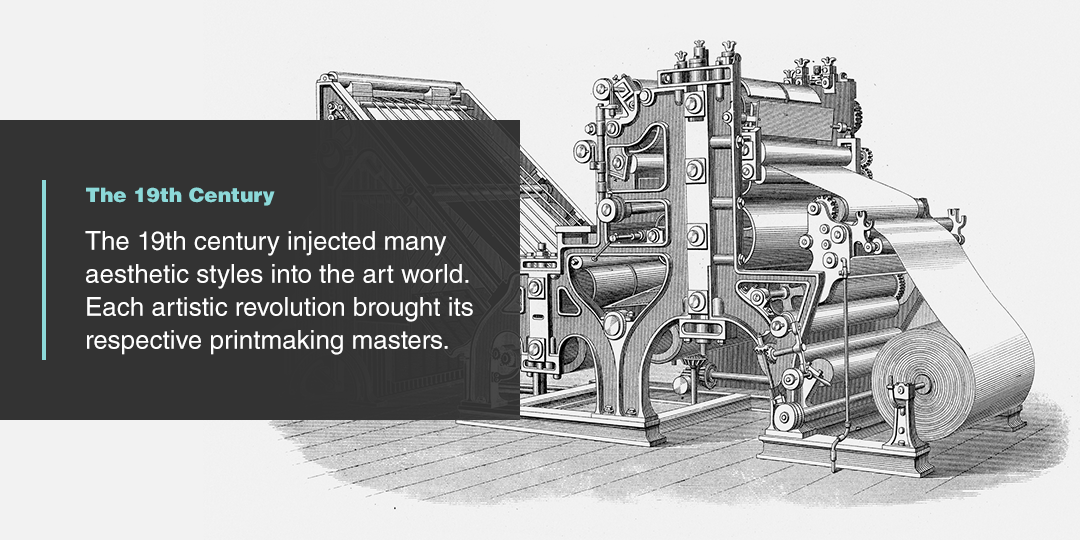
The 19th Century
The 19th century injected many aesthetic styles into the art world. Each artistic revolution brought its respective printmaking masters. The German invention of lithography presented a new medium to artists, while the French influence dominated the European printmaking world. After a few decades of producing masterful lithographs, the country saw an artistic revolution at mid-century with the Barbizon school. The Barbizon school printmakers created landscape etchings that laid the groundwork for the Impressionists to come. Other Barbizon school acolytes depicted peasant life.
Though known for their use of color, Impressionists like Édouard Manet, Edgar Degas and Camille Pissarro created etchings, lithographs and monoprints in their distinct styles. Meanwhile, Japanese woodcuts made their way into Western consciousness. The Japanese artworks’ exoticism, simplicity and abstractions influenced Paul Gauguin, Henri de Toulouse-Lautrec and the American Impressionist Mary Cassatt.
As the country’s influence spread, Japanese artists continued to flourish and develop new printmaking techniques. The woodcut master, Hokusai, was prolific, with a body of work encompassing 35,000 drawings and prints. His series “The 36 Views of Mount Fuji” is perhaps his most popular and includes the famed color print, “The Breaking Wave off Kanagawa.” Hiroshige, another Japanese artist, gained fame in Europe for his Impressionist-like style.
The 20th and 21st Centuries
After the invention of photography, art was no longer necessary as a reproduction tool, which let printmaking and other art forms return to creativity and experimentation. As art exploded throughout the beginning of the 20th century, many of the era’s most famous artists explored printmaking. While known for his paintings, Pablo Picasso also created over 1,000 prints from woodcuts, linocuts, lithographs, etchings, drypoints and engravings.
Other France-based artists, including Georges Braque, Henri Matisse and Georges Rouault, experimented with the form. In the century’s second half, artists created more prints and introduced more technical innovations than ever before.
As traditional printmaking as an art form flourished, modern printing techniques were also born. Printing as we think of it today began when Chester S. Carlson invented the photocopy in 1938. Later popularized by the Xerox Corporation, the technology involved dry toner powder rather than ink. The machines used static electricity to bind the powder to paper. In 1969, inventor Gary Starkweather introduced laser printing, which used a laser to bond the dry toner to the page.
The inkjet printer came on the scene in 1976, and it is still the preferred method used for fine art printing today. Japanese inventor Ichiro Endo developed the technology while working for Canon. The technology works by spraying tiny ink dots onto a page to form an image. In 1985, the IRIS printer came to market, becoming the first large-format digital printer. It was the first commercial printer adapted for fine art printing in the late 1980s and early 1990s.
Printer Jack Duganne coined the word “giclee” in 1991 to market inkjet printing to the fine art world. It made the yet-untested technology sound more refined and dignified. The IRIS printer remained the most popular fine art printer until the 2010s, when the Epson and Canon printing companies developed newer, cheaper technologies that accommodated archival inks.
Online Giclee Printing, Simplified.
Easy ordering, clear pricing, fast delivery.
The Tribeca Printworks Online Print Studio simplifies the process of made-to-order custom printing and framing. Order right from your computer without sacrificing any of the options of our full service NYC studio.
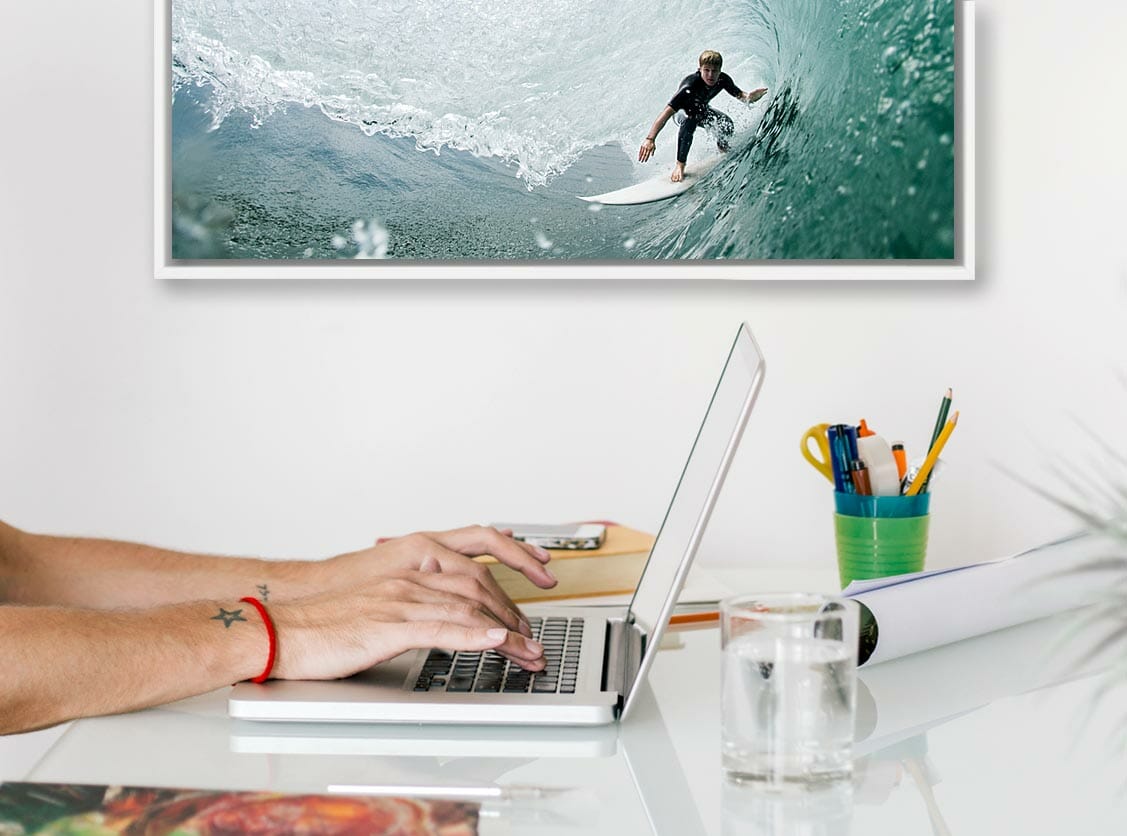
 The Digital Printmaking Process
The Digital Printmaking Process
Whereas traditional printmaking uses one of several techniques to transfer a carved image onto paper or cloth using a printing matrix or plate, modern digital printing transfers the images directly onto the substrate using a digital image file.
Digital printing techniques can render images onto many orthodox and unorthodox materials, including fine art paper, canvas, aluminum and acrylic. While the final product varies with the printing technique, every method starts with printing an image using an inkjet printer. At Tribeca Printworks, we use the Epson P20000 large format printer, which allows us to print images with unrivaled definition and depth in many custom sizes.
As part of the printing process, we select the right type of ink technology for the chosen substrate. Printing on acid-free museum grade fine art paper or canvas requires aqueous ink. At Tribeca Printworks, we use a pigmented ink, which means pigmented particles are suspended within the liquid water molecules. Using a pigmented ink lets the finished piece last longer and resist fading when exposed to sunlight.
The inkjet printing technique employed in giclee paper and canvas printing uses a small ink nozzle to spray microscopic ink droplets onto the page. The term “giclee,” which comes from the French word for “to spray,” refers to this process. The Epson P20000 printer we use at Tribeca Printworks can expel droplets onto the page with astonishing accuracy. The ink nozzles contain piezo crystals, which vibrate, causing the ink to eject from the nozzle.
When printing onto aluminum, we use a process called dye-sublimation rather than inkjet printing alone. Dye-sublimation occurs when solid ink converts into gas and back into a solid, skipping its liquid state. When using dye-sublimation for aluminum, we first print the image using an inkjet printer. When we use a heat press to transfer the image onto aluminum, the temperatures get as hot as 350 to 400 degrees. These conditions cause the dye to sublimate, and after a few minutes, the image is permanently affixed to the aluminum.
Types of Digital Fine Art Printmaking
At Tribeca Printworks, we use archival pigment inks and printing substrates alongside high-resolution digital inkjet printers to achieve museum-quality fine art and photography prints. Today’s modern printing techniques include the following four printing methods:
1. Fine Art Giclee Paper
Photographers and fine artists often want paper reproductions of their works to hang in galleries or sell to their customers. Fine art printing on paper lets these creators create many copies of their pieces at an affordable price. Likewise, it allows their customers to enjoy the beauty of fine art in their homes without the high price tag of an original painting. The techniques involved in giclee printing on paper produce a gallery-quality print in vibrant colors, defined detail and considerable depth.
As opposed to regular photo paper, fine art printing paper incorporates cotton fibers or cellulose and has a neutral pH. The paper itself is thick and durable, locking in pigmentation while retaining clarity and detail. Artists can choose from many paper options from the brands Hahnemühle and Epson to achieve glossy, matte, textured or metallic effects.
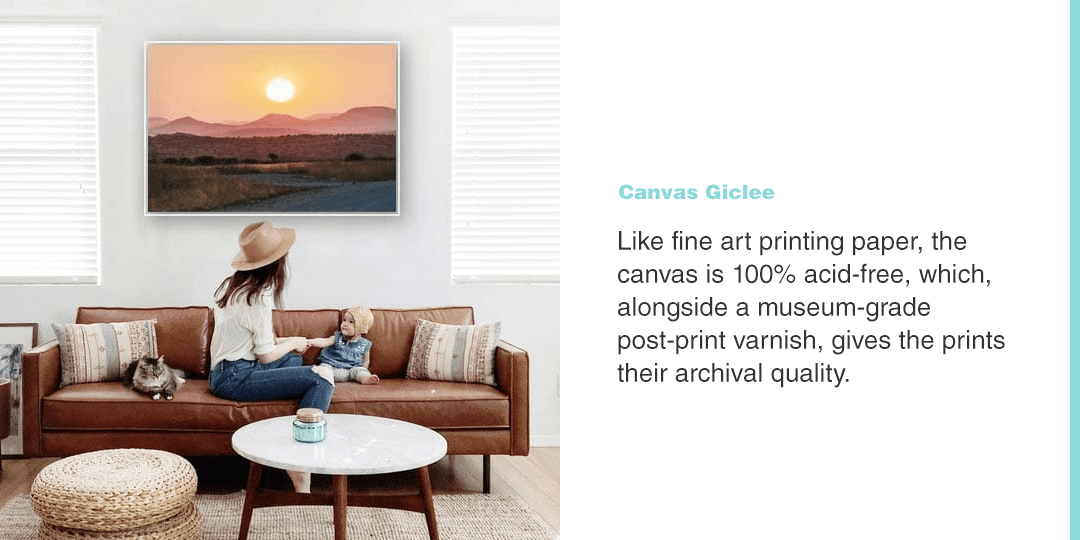
2. Canvas Giclee
Painters have long used stretched canvas for their original artworks, and fine art printing on canvas lets both artists and photographers create reproductions on this material. Its natural texture adds depth, and the wooden frame provides an alternative to traditional framed photos. You can choose from unprinted or mirrored edges or add a floater frame for a more finished appearance.
Like fine art printing paper, the canvas is 100% acid-free, which, alongside a museum-grade post-print varnish, gives the prints their archival quality. At Tribeca Printworks, we can hand-stretch our canvas around custom stretcher bars or provide print-only services for your hand-stretched canvases.
3. HD Aluminum
Printing photos and artwork on HD aluminum provides another attractive alternative to a traditional frame. The metal printing substrate creates a sleek effect with vibrant colors and incredible detail. With aluminum, you can choose from glossy and matte white finishes, ideal for color photography and artwork. Black and white photographs and other high-contrast images can achieve a unique effect on silver aluminum. The photo’s light areas will reveal the brushed silver texture underneath for a captivating, dramatic effect.
Of all the printing processes at your disposal, aluminum is the most durable. The metal will resist scratches and can be wiped clean with a damp cloth as needed. It will also hold up better to humidity and other elements.
Printing on aluminum is a different process from the inkjet techniques appropriate for paper and canvas prints. The dye-sublimation process begins with a .045-inch aluminum plate with a white or clear coating. We first print the image onto transfer paper using inkjet archival inks. Next, we fuse the transfer paper to the aluminum using a high-temperature heat press. For frameless mounts, we attach the plate to a 3/4-inch wooden backing. We can also use a black or white floater frame for a more finished look.
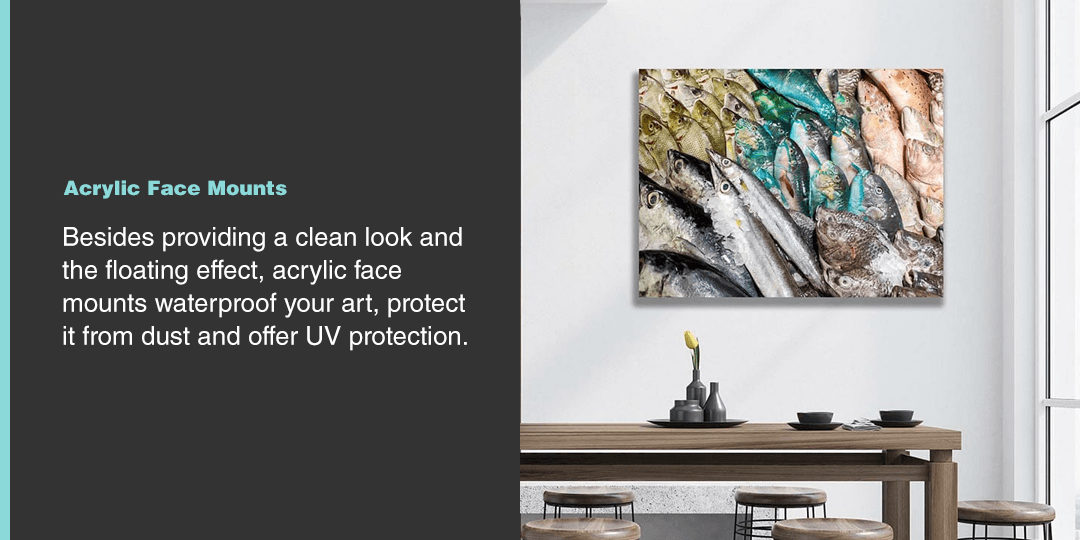
4. Acrylic Face Mounts
Acrylic face mounts preserve artwork and photographs beneath clear plexiglass to create a modern, frameless print. We make these prints by first rendering your artwork onto glossy or metallic photo paper. We then permanently affix the printed image to a matte or glossy acrylic panel using a clear double-sided adhesive. We back the image with a wooden cleated platform to support the print while framing. Next, we diamond-polish the acrylic face mount around the edges to add shine and lock the image into place.
Besides providing a clean look and the floating effect, acrylic face mounts waterproof your art, protect it from dust and offer UV protection.
Comparing Commercial Printing and Printmaking
Printmaking is a long-standing art form that has been used over the centuries for both commercial mass production purposes and fine art. The same can be said for commercial fine art printing. The advent of digital printers makes perfect reproductions more possible and affordable for artists. Like photography, giclee photo and fine art printing have allowed traditional printmaking to serve its true calling as its own artistic medium. Traditional printmakers no longer have to worry about reproducing other images, and they have the freedom to explore and experiment with their craft.
Giclee printing methods and final products look quite different from the hand-drawn images immortalized in ink and printing plates. Still, the technique requires expertise and a careful eye to capture a piece’s artistic intent and visual effect. To create gallery-quality prints like we do at Tribeca Printworks, we first start by selecting the right printmaking materials.
For example, our photographers often print on aluminum. With traditional metal engraving or metal etching, the image is carved or burned into an aluminum surface and then transferred to paper. When we print on HD aluminum, the process is reversed. First, we print the photo on transfer paper using archival pigment inks. Then, we unite the paper to a brushed aluminum surface, producing a sleek print with brilliant colors. Depending on the chosen finish, the raw metal may be visible or invisible in the final product.
Today’s digital printing owes much to the traditional printmaking methods that came before it. Artists and master printmakers have been studying different inks and the science of transferring images to printing plates, paper and fabric for centuries. The earliest forms of printmaking allowed artists to produce copies of their work quickly.
Advancements like lithography have allowed printers to layer multiple colors and print a wider variety of images. While the technology has seen many improvements since the lithograph and other early printmaking forms, we benefit from this technology every time we create a digital giclee print using an inkjet printer.
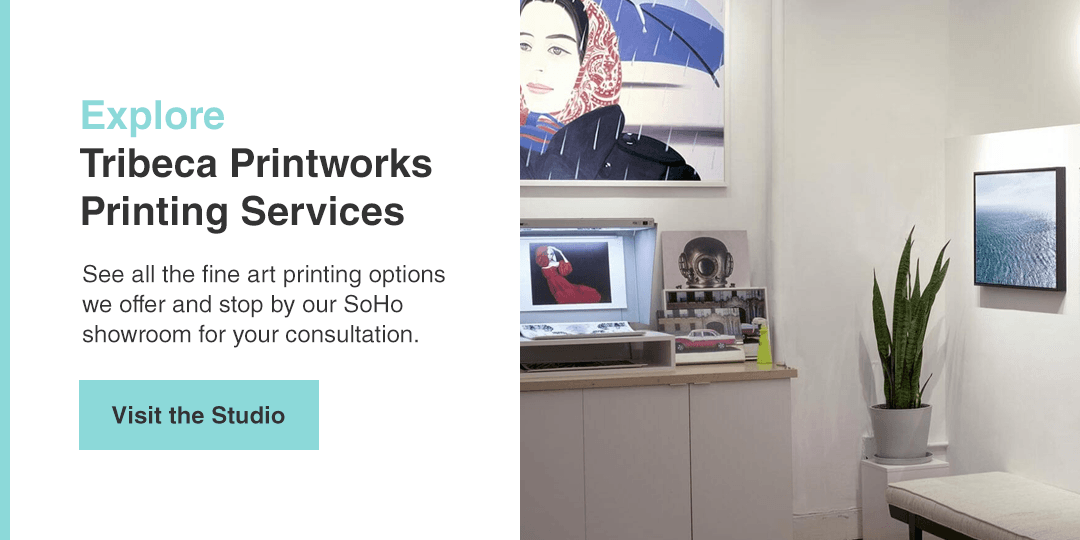
Explore Tribeca Printworks Printing Services
At Tribeca Printworks, we bring careful craft and technical skill to every printing service we provide. As photographers and painters ourselves, we collaborate with you to review art files and discuss printing materials until we find the combination that brings out the best in your work. Once we’re ready to print, we obsess over every detail until we get the colors just right.
If you’d like to frame your work, our in-house custom frame shop will create your frame by hand. See all the fine art printing options we offer and stop by our SoHo showroom for your consultation.

